Abstract
Plasma glutathione S-transferase (GST) measurements have been used to study early changes in hepatocellular integrity after paracetamol overdose and treatment with N-acetylcysteine (NAC). Patients admitted within seven hours and successfully treated had raised or equivocal GST on admission and each showed a transient peak in GST approximately 12 hours after the overdose. Similar, though smaller changes in GST, were seen in untreated patients whose paracetamol level fell below the treatment line. The plasma GST concentrations in successfully treated patients were small compared with values found in patients who subsequently developed severe liver damage. The changes in GST concentration observed in patients who developed severe liver damage indicated that distinct early and late phases of paracetamol-induced hepatotoxicity occurred. Although the mechanism by which paracetamol exerts its early toxic effect is unclear, our data suggest that prompt treatment with NAC can successfully prevent both clinical and subclinical hepatotoxicity in this early period.
Full text
PDF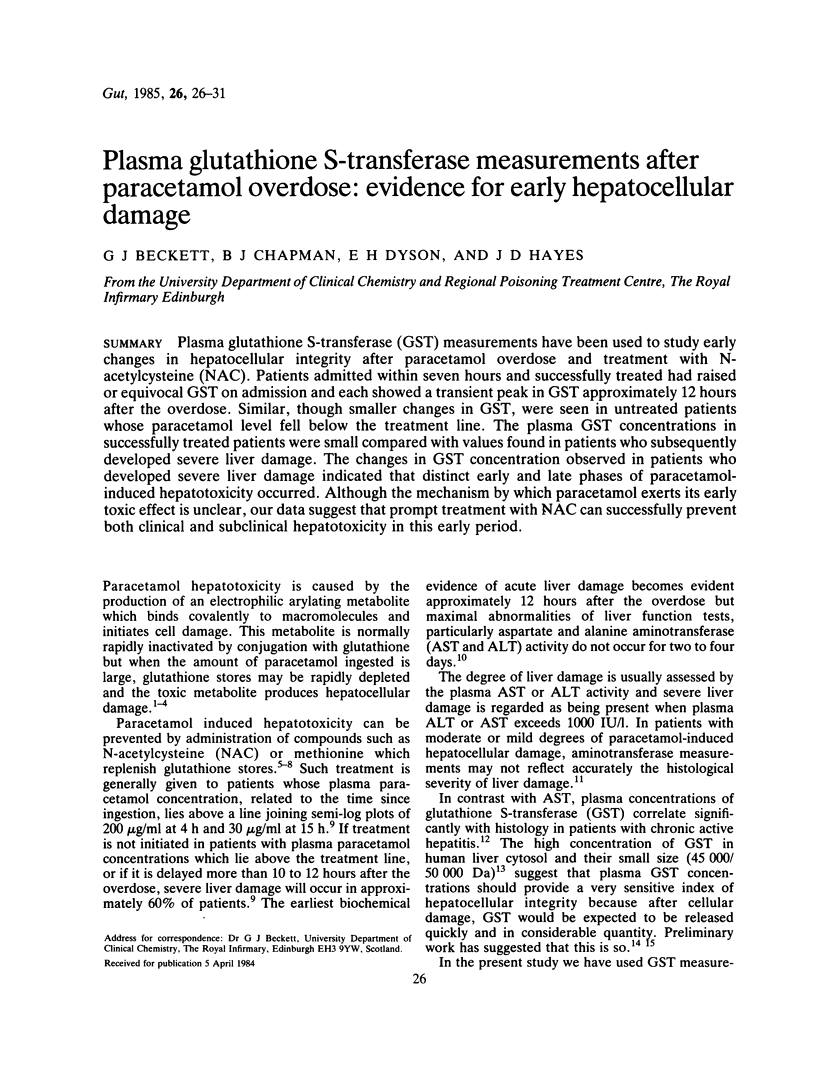
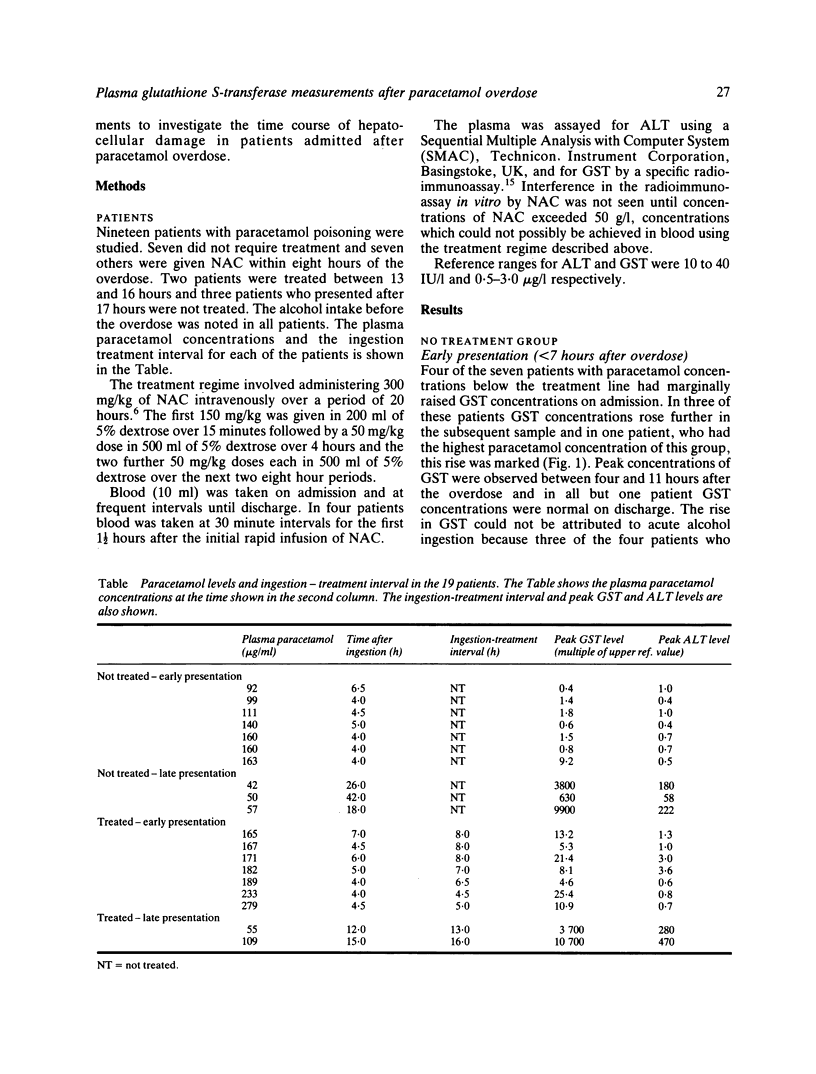
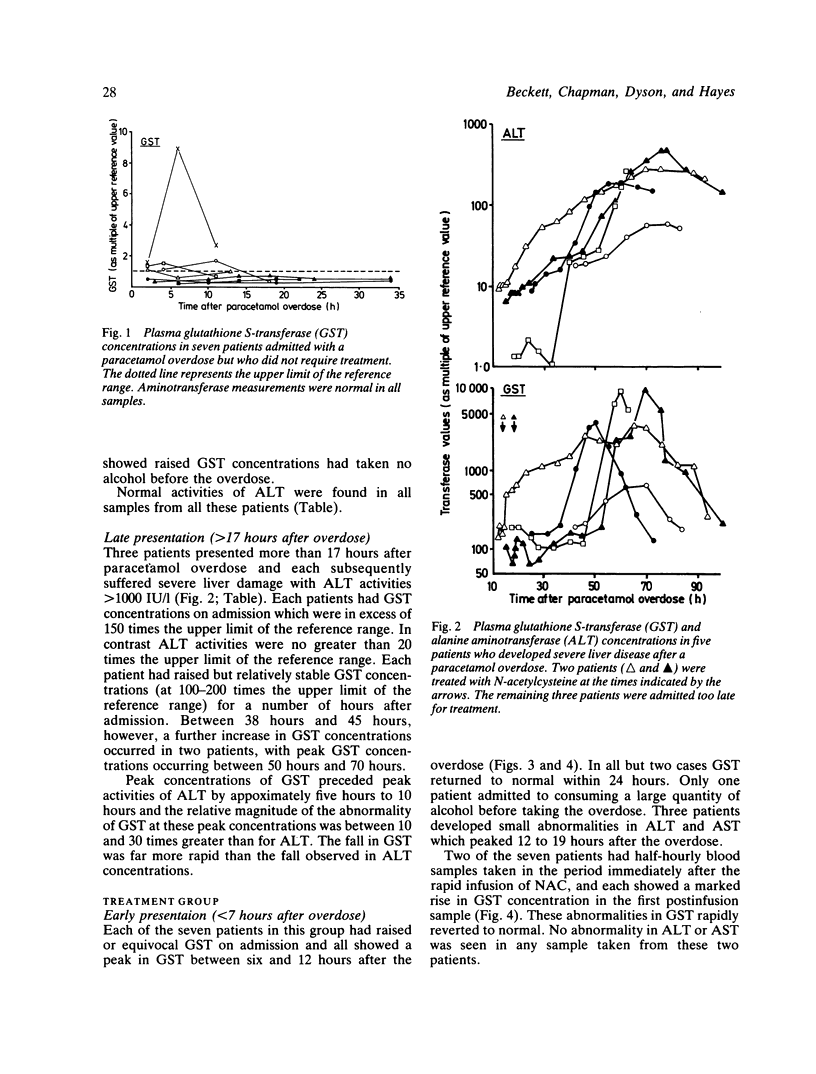
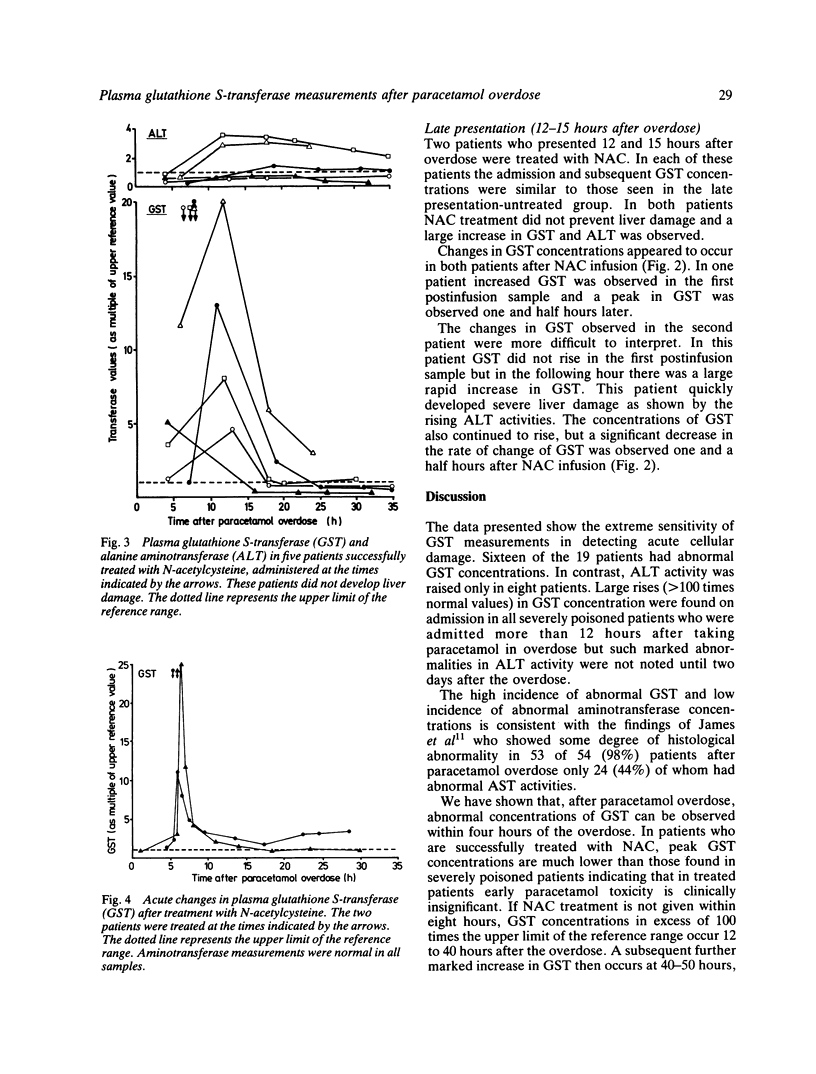
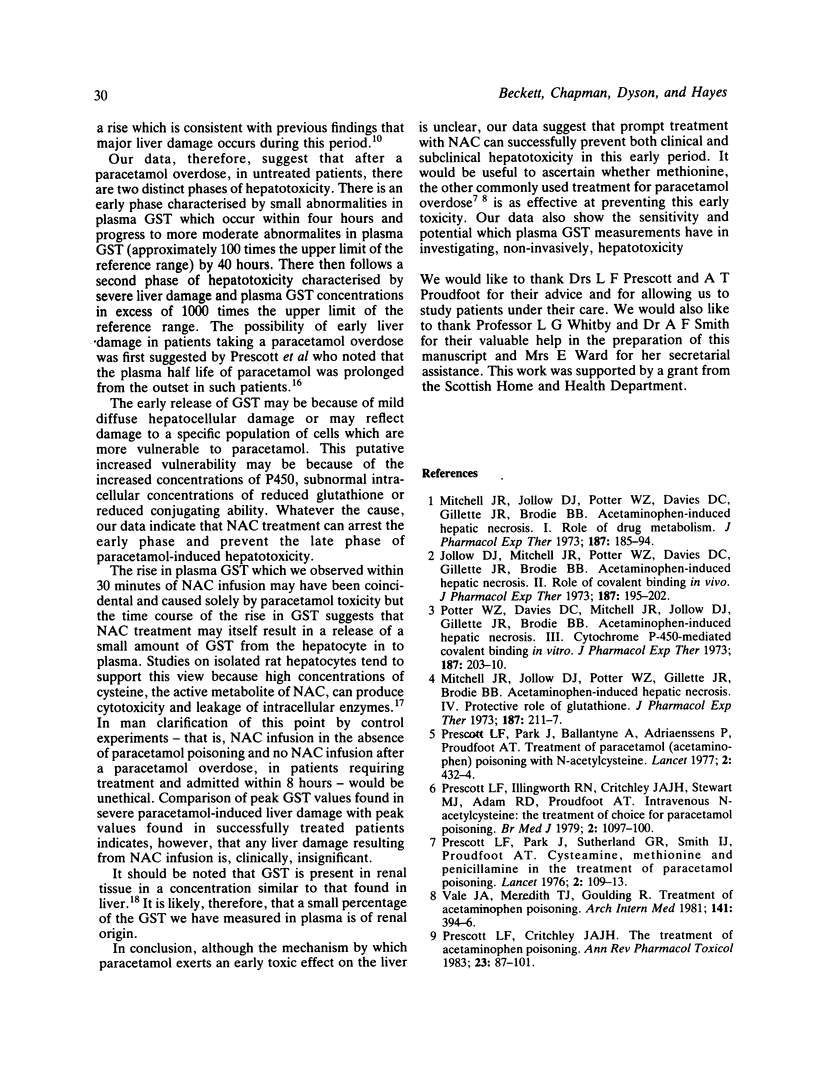
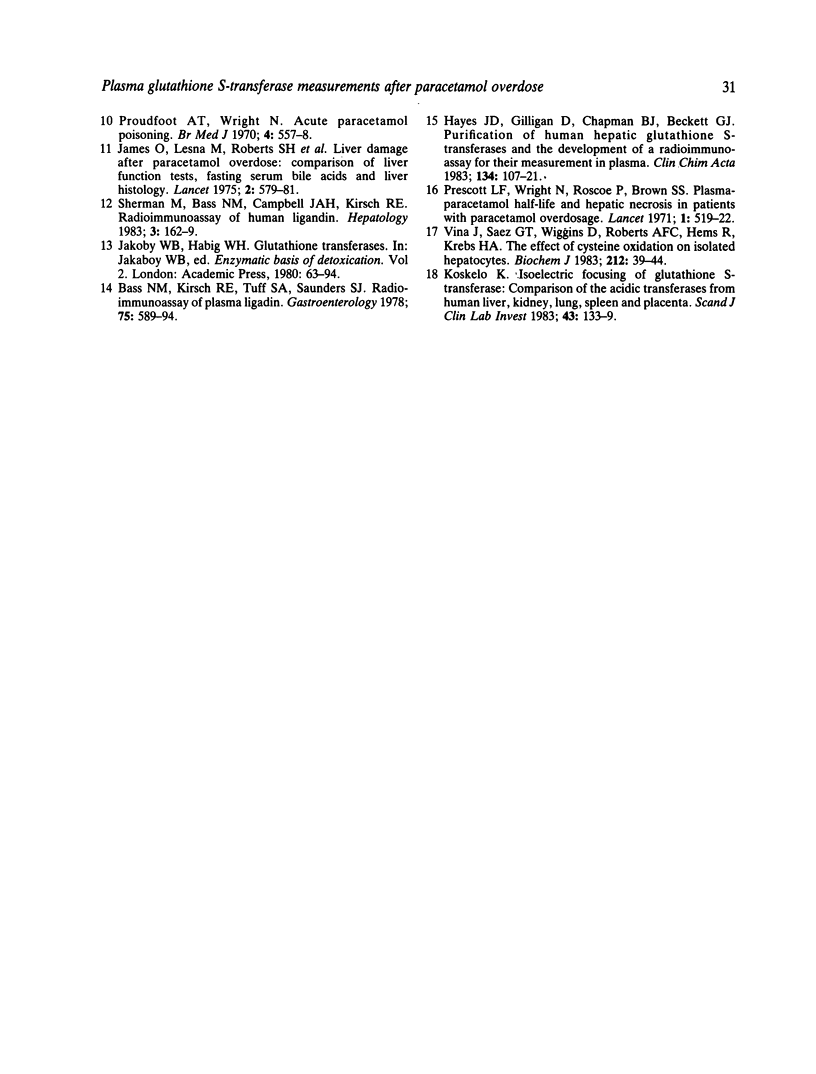
Selected References
These references are in PubMed. This may not be the complete list of references from this article.
- Bass N. M., Kirsch R. E., Tuff S. A., Saunders S. J. Radioimmunoassay of plasma ligandin: a sensitive index of experimental hepatocellular necrosis. Gastroenterology. 1978 Oct;75(4):589–594. [PubMed] [Google Scholar]
- Hayes J. D., Gilligan D., Chapman B. J., Beckett G. J. Purification of human hepatic glutathione S-transferases and the development of a radioimmunoassay for their measurement in plasma. Clin Chim Acta. 1983 Oct 31;134(1-2):107–121. doi: 10.1016/0009-8981(83)90189-4. [DOI] [PubMed] [Google Scholar]
- James O., Lesna M., Roberts S. H., Pulman L., Douglas A. P., Smith P. A., Watson A. J. Liver damage after paracetamol overdose. Comparison of liver-function tests, fasting serum bile acids, and liver histology. Lancet. 1975 Sep 27;2(7935):579–581. doi: 10.1016/s0140-6736(75)90170-1. [DOI] [PubMed] [Google Scholar]
- Jollow D. J., Mitchell J. R., Potter W. Z., Davis D. C., Gillette J. R., Brodie B. B. Acetaminophen-induced hepatic necrosis. II. Role of covalent binding in vivo. J Pharmacol Exp Ther. 1973 Oct;187(1):195–202. [PubMed] [Google Scholar]
- Koskelo K. Isoelectric focusing of glutathione S-transferases: comparison of the acidic transferases from human liver, kidney, lung, spleen and placenta. Scand J Clin Lab Invest. 1983 Apr;43(2):133–139. doi: 10.1080/00365518309168235. [DOI] [PubMed] [Google Scholar]
- Mitchell J. R., Jollow D. J., Potter W. Z., Davis D. C., Gillette J. R., Brodie B. B. Acetaminophen-induced hepatic necrosis. I. Role of drug metabolism. J Pharmacol Exp Ther. 1973 Oct;187(1):185–194. [PubMed] [Google Scholar]
- Mitchell J. R., Jollow D. J., Potter W. Z., Gillette J. R., Brodie B. B. Acetaminophen-induced hepatic necrosis. IV. Protective role of glutathione. J Pharmacol Exp Ther. 1973 Oct;187(1):211–217. [PubMed] [Google Scholar]
- Potter W. Z., Davis D. C., Mitchell J. R., Jollow D. J., Gillette J. R., Brodie B. B. Acetaminophen-induced hepatic necrosis. 3. Cytochrome P-450-mediated covalent binding in vitro. J Pharmacol Exp Ther. 1973 Oct;187(1):203–210. [PubMed] [Google Scholar]
- Prescott L. F., Critchley J. A. The treatment of acetaminophen poisoning. Annu Rev Pharmacol Toxicol. 1983;23:87–101. doi: 10.1146/annurev.pa.23.040183.000511. [DOI] [PubMed] [Google Scholar]
- Prescott L. F., Illingworth R. N., Critchley J. A., Stewart M. J., Adam R. D., Proudfoot A. T. Intravenous N-acetylcystine: the treatment of choice for paracetamol poisoning. Br Med J. 1979 Nov 3;2(6198):1097–1100. doi: 10.1136/bmj.2.6198.1097. [DOI] [PMC free article] [PubMed] [Google Scholar]
- Prescott L. F., Park J., Ballantyne A., Adriaenssens P., Proudfoot A. T. Treatment of paracetamol (acetaminophen) poisoning with N-acetylcysteine. Lancet. 1977 Aug 27;2(8035):432–434. doi: 10.1016/s0140-6736(77)90612-2. [DOI] [PubMed] [Google Scholar]
- Prescott L. F., Roscoe P., Wright N., Brown S. S. Plasma-paracetamol half-life and hepatic necrosis in patients with paracetamol overdosage. Lancet. 1971 Mar 13;1(7698):519–522. doi: 10.1016/s0140-6736(71)91125-1. [DOI] [PubMed] [Google Scholar]
- Prescott L. F., Sutherland G. R., Park J., Smith I. J., Proudfoot A. T. Cysteamine, methionine, and penicillamine in the treatment of paracetamol poisoning. Lancet. 1976 Jul 17;2(7977):109–113. doi: 10.1016/s0140-6736(76)92842-7. [DOI] [PubMed] [Google Scholar]
- Proudfoot A. T., Wright N. Acute paracetamol poisoning. Br Med J. 1970 Sep 5;3(5722):557–558. doi: 10.1136/bmj.3.5722.557. [DOI] [PMC free article] [PubMed] [Google Scholar]
- Sherman M., Bass N. M., Campbell J. A., Kirsch R. E. Radioimmunoassay of human ligandin. Hepatology. 1983 Mar-Apr;3(2):162–169. doi: 10.1002/hep.1840030205. [DOI] [PubMed] [Google Scholar]
- Vale J. A., Meredith T. J., Goulding R. Treatment of acetaminophen poisoning. The use of oral methionine. Arch Intern Med. 1981 Feb 23;141(3 Spec No):394–396. doi: 10.1001/archinte.141.3.394. [DOI] [PubMed] [Google Scholar]
- Viña J., Saez G. T., Wiggins D., Roberts A. F., Hems R., Krebs H. A. The effect of cysteine oxidation on isolated hepatocytes. Biochem J. 1983 Apr 15;212(1):39–44. doi: 10.1042/bj2120039. [DOI] [PMC free article] [PubMed] [Google Scholar]


